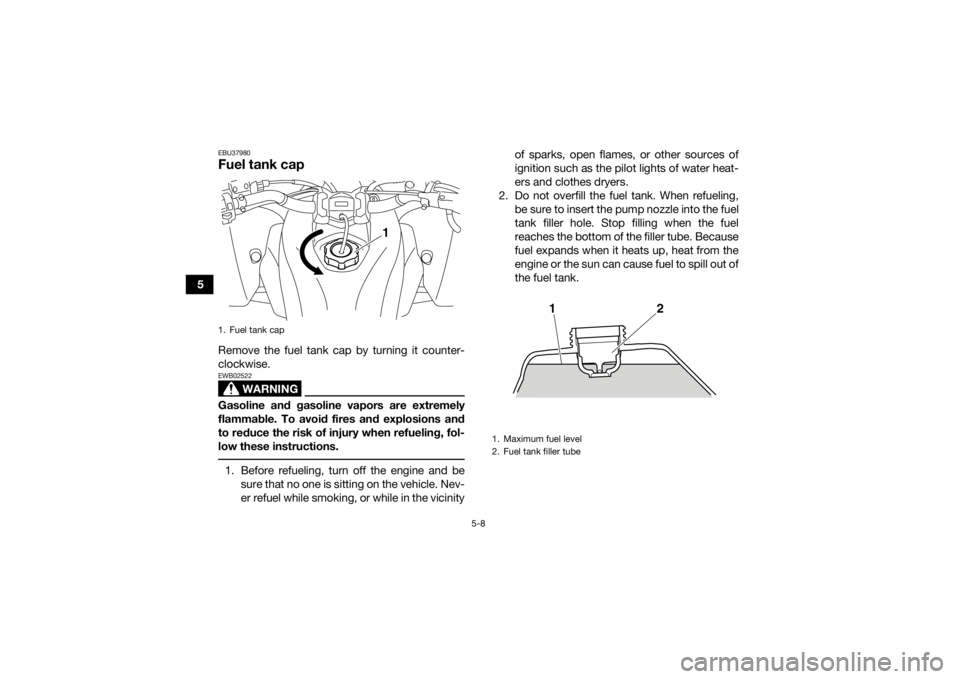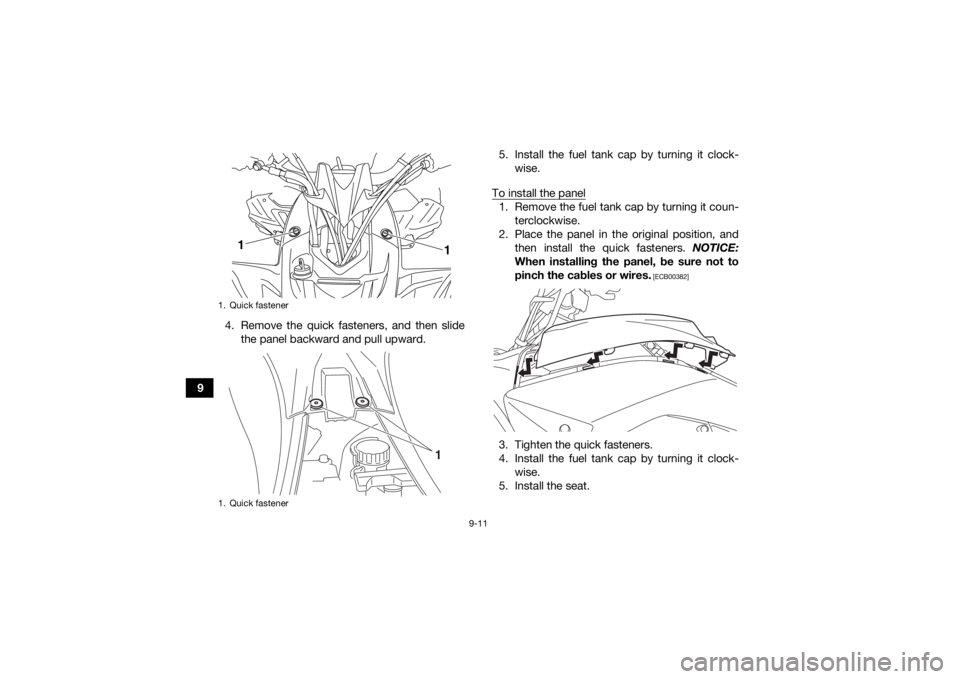2021 YAMAHA YFZ450R fuel cap
[x] Cancel search: fuel capPage 8 of 150

EBU17421
TABLE OF CONTENTS
VEHICLE IDENTIFICATION ............................ 1-1Identification numbers ................................ 1-1
LOCATION OF THE WARNING AND
SPECIFICATION LABELS .............................. 2-1
SAFETY INFORMATION ................................ 3-1
DESCRIPTION................................................ 4-1 Left view ...................................................... 4-1
Right view.................................................... 4-1
Controls and instruments............................ 4-2
INSTRUMENT AND CONTROL
FUNCTIONS ................................................... 5-1 Main switch ................................................. 5-1
Indicator light and warning lights ................ 5-1
Handlebar switches .................................... 5-3
Throttle lever ............................................... 5-4
Speed limiter ............................................... 5-4
Clutch lever ................................................. 5-5
Brake lever .................................................. 5-5
Brake pedal ................................................. 5-6
Parking brake lever ..................................... 5-6 Shift pedal................................................... 5-7
Fuel tank cap .............................................. 5-8
Fuel ............................................................. 5-9
Seat .......................................................... 5-10
Front shock absorbers ............................ 5-11
Rear shock absorber ................................ 5-15
Handlebar position ................................... 5-23
PRE-OPERATION CHECKS .......................... 6-1 Fuel ............................................................. 6-4
Engine oil .................................................... 6-4
Coolant ....................................................... 6-4
Front and rear brakes ................................. 6-4
Throttle lever ............................................... 6-5
Drive chain .................................................. 6-5
Tires ............................................................ 6-5
Chassis fasteners ....................................... 6-7
Instruments, lights and switches ................ 6-7
OPERATION .................................................. 7-1 Starting the engine ..................................... 7-1
Shifting........................................................ 7-2
Engine break-in........................................... 7-4
Parking........................................................ 7-4UBKD60E0.book Page 1 Wednesday, November 18, 2020 8:39 AM
Page 23 of 150

3-5
3
4. Once immediate safety hazards are con-
firmed not to exist, you may remove your hel-
met to more closely inspect your vehicle.
Check for external signs of wear, broken
parts, fluid leaks, cracks in the frame, sus-
pension damage, wheel damage, and so on.
Fuel, oil, and coolant usually give off a notice-
able odor.
5. If your vehicle will not restart or if it is unsafe to ride, then turn off all vehicle systems (en-
gine stop switch, main switch, and fuel cock),
and then signal or go for help.
Aftermarket Parts, Accessories, and Modifica-
tions
While you may find aftermarket products similar in
design and quality to genuine Yamaha accesso-
ries, recognize that some aftermarket accessories
or modifications are not suitable because of po-
tential safety hazards to you or others. Installing
aftermarket products or having other modifica-
tions performed to your vehicle that change any of
the vehicle’s design or operation characteristics
can put you and others at greater risk of serious
injury or death. You are responsible for injuries re-
lated to changes in the vehicle. Keep the following guidelines in mind, as well as those found in the
Loading section (page 7-6) when mounting acces-
sories.
Never install accessories that would impair the
performance of your ATV. Carefully inspect the
accessory before using it to make sure that it
does not in any way reduce ground clearance,
limit suspension travel, steering travel or control
operation.
Accessories fitted to the ATV can create insta-
bility due to improper weight distribution.
Bulky or large accessories may seriously affect
the stability of the ATV.
Certain accessories can displace the operator
from his or her normal riding position. This im-
proper position limits the freedom of movement
of the operator and may limit control ability,
therefore, such accessories are not recom-
mended.
Use caution when adding electrical accesso-
ries. If electrical accessories exceed the capac-
ity of the ATV’s electrical system, an electric
failure could result, which could cause a dan-
gerous loss of lights or engine power. Also, the
battery tends to discharge more quickly if elec-
trical accessories are added.
UBKD60E0.book Page 5 Wednesday, November 18, 2020 8:39 AM
Page 25 of 150

4-1
4
EBU17681
DESCRIPTION
EBU17691Left view
EBU17701Right view
1. Front shock absorber
2. Engine oil tank filler cap
3. Rear brake fluid reservoir
4. Battery
5. Shift pedal
6. Coolant reservoir
563
1
4
2
1. Spark arrester
2. Fuse
3. Fuel tank cap
4. Oil filter element
5. Brake pedal
6. Rear brake light switch
7. Rear shock absorber
456
2
1
7
3
UBKD60E0.book Page 1 Wednesday, November 18, 2020 8:39 AM
Page 34 of 150

5-8
5
EBU37980Fuel tank capRemove the fuel tank cap by turning it counter-
clockwise.
WARNING
EWB02522Gasoline and gasoline vapors are extremely
flammable. To avoid fires and explosions and
to reduce the risk of injury when refueling, fol-
low these instructions. 1. Before refueling, turn off the engine and besure that no one is sitting on the vehicle. Nev-
er refuel while smoking, or while in the vicinity of sparks, open flames, or other sources of
ignition such as the pilot lights of water heat-
ers and clothes dryers.
2. Do not overfill the fuel tank. When refueling, be sure to insert the pump nozzle into the fuel
tank filler hole. Stop filling when the fuel
reaches the bottom of the filler tube. Because
fuel expands when it heats up, heat from the
engine or the sun can cause fuel to spill out of
the fuel tank.1. Fuel tank cap
1
1. Maximum fuel level
2. Fuel tank filler tube
2
1
UBKD60E0.book Page 8 Wednesday, November 18, 2020 8:39 AM
Page 35 of 150
![YAMAHA YFZ450R 2021 Owners Manual 5-9
5
3. Wipe up any spilled fuel immediately.
NOTICE: Immediately wipe off spilled fuel
with a clean, dry, soft cloth, since fuel may
deteriorate painted surfaces or plastic
parts.
[ECB00982]
4. Tu YAMAHA YFZ450R 2021 Owners Manual 5-9
5
3. Wipe up any spilled fuel immediately.
NOTICE: Immediately wipe off spilled fuel
with a clean, dry, soft cloth, since fuel may
deteriorate painted surfaces or plastic
parts.
[ECB00982]
4. Tu](/manual-img/51/53831/w960_53831-34.png)
5-9
5
3. Wipe up any spilled fuel immediately.
NOTICE: Immediately wipe off spilled fuel
with a clean, dry, soft cloth, since fuel may
deteriorate painted surfaces or plastic
parts.
[ECB00982]
4. Turn the fuel tank cap fully clockwise to make sure it is securely closed.EBU38170FuelMake sure there is sufficient gasoline in the tank
before starting off. Refuel if necessary.
WARNING
EWB02532Gasoline is poisonous and can cause injury or
death. Handle gasoline with care. Never siphon
gasoline by mouth. If you should swallow some
gasoline or inhale a lot of gasoline vapor, or get
some gasoline in your eyes, see your doctor
immediately. If gasoline spills on your skin,
wash with soap and water. If gasoline spills on
your clothing, change your clothes.
TIPConfirm the gasoline pump nozzle has the same
fuel identification mark. Recommended fuel:Premium unleaded gasoline (Gasohol [E10]
acceptable)
Fuel tank capacity: 10 L (2.6 US gal, 2.2 Imp.gal)
Fuel reserve amount: 3.4 L (0.90 US gal, 0.75 Imp.gal)1. EN228 fuel identification mark
1
E5
E10
UBKD60E0.book Page 9 Wednesday, November 18, 2020 8:39 AM
Page 95 of 150

9-10
9
EBU30131Removing and installing the cowling
and panelsThe cowling and panels shown need to be re-
moved to perform some of the maintenance jobs
described in this chapter. Refer to this section
each time a cowling or panel needs to be removed
and installed.
EBU29596Panel A
To remove the panel1. Remove the seat. (See page 5-10.)
2. Remove the fuel tank cap by turning it coun-terclockwise. (See page 5-8.) NOTICE: Make
sure that no foreign material enters the
fuel tank.
[ECB01052]
3. Loosen the quick fasteners.
1. Panel A
2. Panel B
3. Cowling
1
2
3
1. Panel C
1
UBKD60E0.book Page 10 Wednesday, November 18, 2020 8:39 AM
Page 96 of 150

9-11
94. Remove the quick fasteners, and then slide
the panel backward and pull upward. 5. Install the fuel tank cap by turning it clock-
wise.
To install the panel
1. Remove the fuel tank cap by turning it coun- terclockwise.
2. Place the panel in the original position, and then install the quick fasteners. NOTICE:
When installing the panel, be sure not to
pinch the cables or wires.
[ECB00382]
3. Tighten the quick fasteners.
4. Install the fuel tank cap by turning it clock- wise.
5. Install the seat.
1. Quick fastener
1. Quick fastener
1 1
1
UBKD60E0.book Page 11 Wednesday, November 18, 2020 8:39 AM
Page 140 of 150

10-2
10abrasives which may mar the paint or protec-
tive finish. When finished cleaning, start the
engine and let it idle for several minutes.
EBU27264StorageShort-term
Always store your ATV in a cool, dry place and, if
necessary, protect it against dust with a porous
cover.
NOTICE: Storing the ATV in a poorly ven-
tilated room or covering it with a tarp while it is
still wet, will allow water and humidity to seep
in and cause rust. To prevent corrosion, avoid
damp cellars, stables (because of the presence
of ammonia) and areas where strong chemi-
cals are stored.
[ECB00722]
Long-term
Before storing your ATV for several months: 1. Make any necessary repairs and perform all outstanding maintenance.
2. Follow all the instructions in the Cleaning sec- tion of this chapter. 3. Fill up the fuel tank and add fuel stabilizer (Fu-
el Med Rx if available), and then run the en-
gine for 5 minutes to distribute the treated
fuel.
4. Perform the following steps to protect the en- gine from internal corrosion.a. Remove the spark plug cap and spark plug.
b. Pour a teaspoonful of engine oil into the spark plug bore.
c. Install the spark plug cap onto the spark plug, and then place the spark plug on the
cylinder head so that the electrodes are
grounded. (This will limit sparking during
the next step.)
d. Turn the engine over several times with the starter. (This will coat the cylinder wall
with oil.)
e. Remove the spark plug cap from the spark plug, and then install the spark plug and
the spark plug cap.
5. Lubricate all control cables and the pivoting points of all levers and pedals.
Specified amount:
7.5 ml per liter of fuel (1 oz per gallon)UBKD60E0.book Page 2 Wednesday, November 18, 2020 8:39 AM